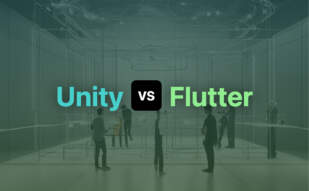Flutter is an open-source UI software development kit cultivated by the brilliant minds at Google. From its inaugural release in May 2017 to the recent unveiling of version 3.7 in January 2023, Flutter has carved a niche for itself. Offering a harmonious blend of C, C++, and Dart languages, Flutter stands tall as a versatile tool usable across a myriad of platforms, aiming for a breathtaking rendering speed of 120 frames per second. An elegant tapestry of capabilities, Flutter caters to the cross-platform development needs of developers worldwide, with a robust widget catalog and a commitment to a singular UI experience across platforms.

Exploring avenues beyond Flutter leads to a realm teeming with possibilities. Venture into the realm of alternatives, where Three.js, WebGL, WebGL 2, WebVR, WebXR, OpenXR, React Three Fiber, p5.js, Pixi.js, Babylon.js, A-Frame, X3DOM, Deck.gl, and VTK.js await the intrepid developers seeking new horizons.
React Native
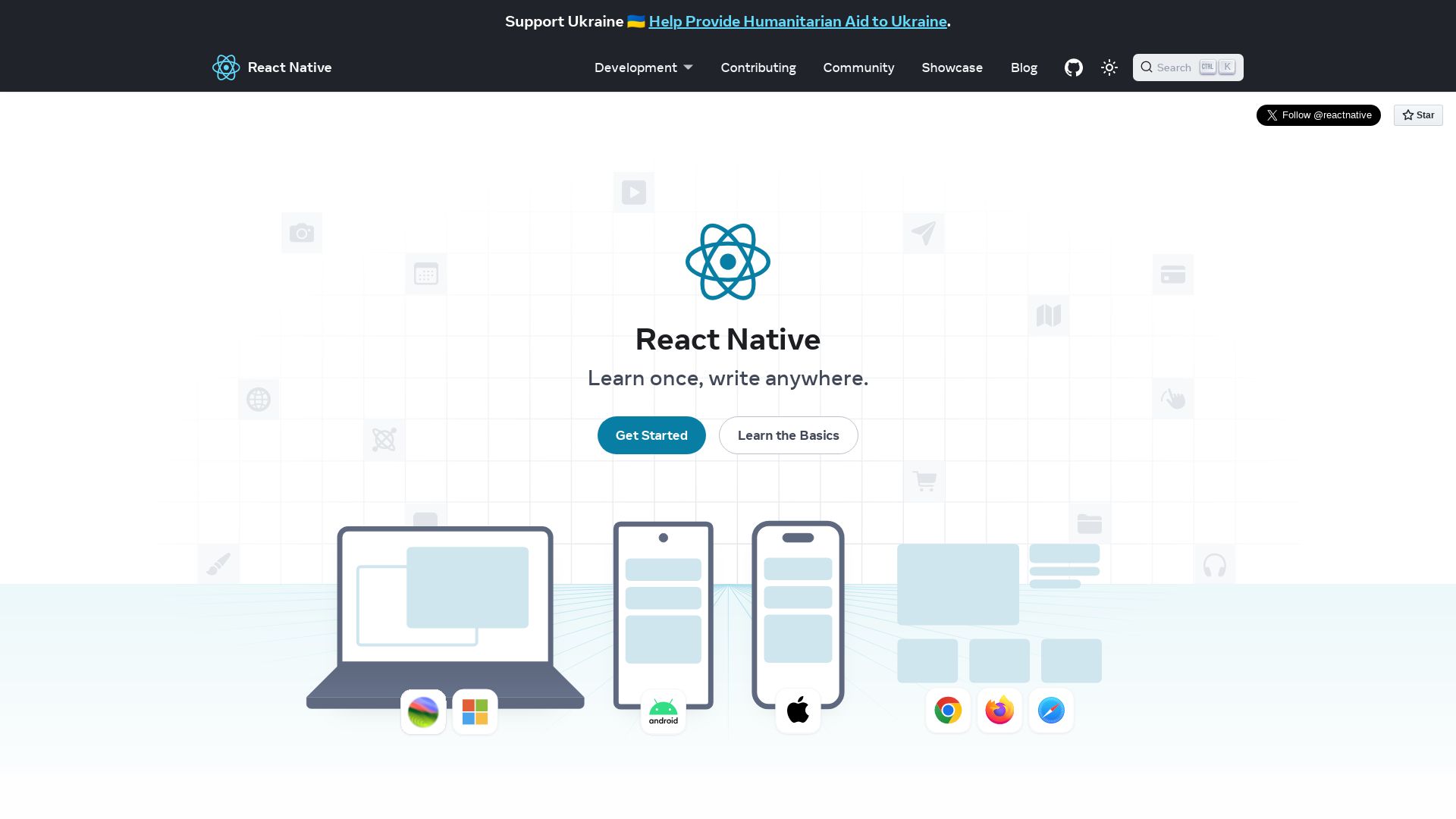
A stellar JavaScript framework, React Native is known for its prowess in creating native apps for Android and iOS blending native development logic with an intuitive JavaScript library.
React Native Top Features
- Employs a common technology, React, to generate platform-specific versions of components from a single codebase, steering clear of compromise on user experiences.
- Harnesses a set of platform agnostic native components that includes View, Text, Image, allowing a single team to manage multiple platforms effectively.
- Significantly accelerates developer iteration time, sidelining the wait for native builds.
- Fruits of a renowned open-source project by Meta Platforms, Inc, React Native provides an extensive list of pre-built components and libraries, aiding developers in speedy application development.
- Stands apart for its inherent native platform communication via serialized data, running directly on the end-device.
| Style | Employs styling similar to CSS but surpasses need for HTML or CSS. |
|---|---|
| Used By | Employs a set of platform agnostic native components providing native features. |
| Runs on | Runs on JavaScriptCore runtime and offers support for new JavaScript (ES6+) features. |
React Native Limitations
- Being a relatively young project, it has maturity issues and requires room for improvement.
- Handling debugging at the intersection of React and the host platform can be complex.
- Does not use web components, opting for native components as building blocks instead.
React Native Pricing
As an open-source project by Meta Platforms, React Native is available free of cost. This aligns with a democratized approach to high-quality application development.
React Native Use Cases
Use case 1
React Native offers a robust solution when developers need to create native applications using JavaScript and React. This addresses the issue of needing multiple teams for Android and iOS development by allowing one team to manage both platforms.
Use case 2
It presents an economic choice for startups as they gain access to a high-quality, yet free platform for native app development.
Use case 3
For operations requiring speedier iteration time without native build waits, React Native appears as the top choice. With its quicker mobile development method, it doesn’t sacrifice on app quality.
Xamarin
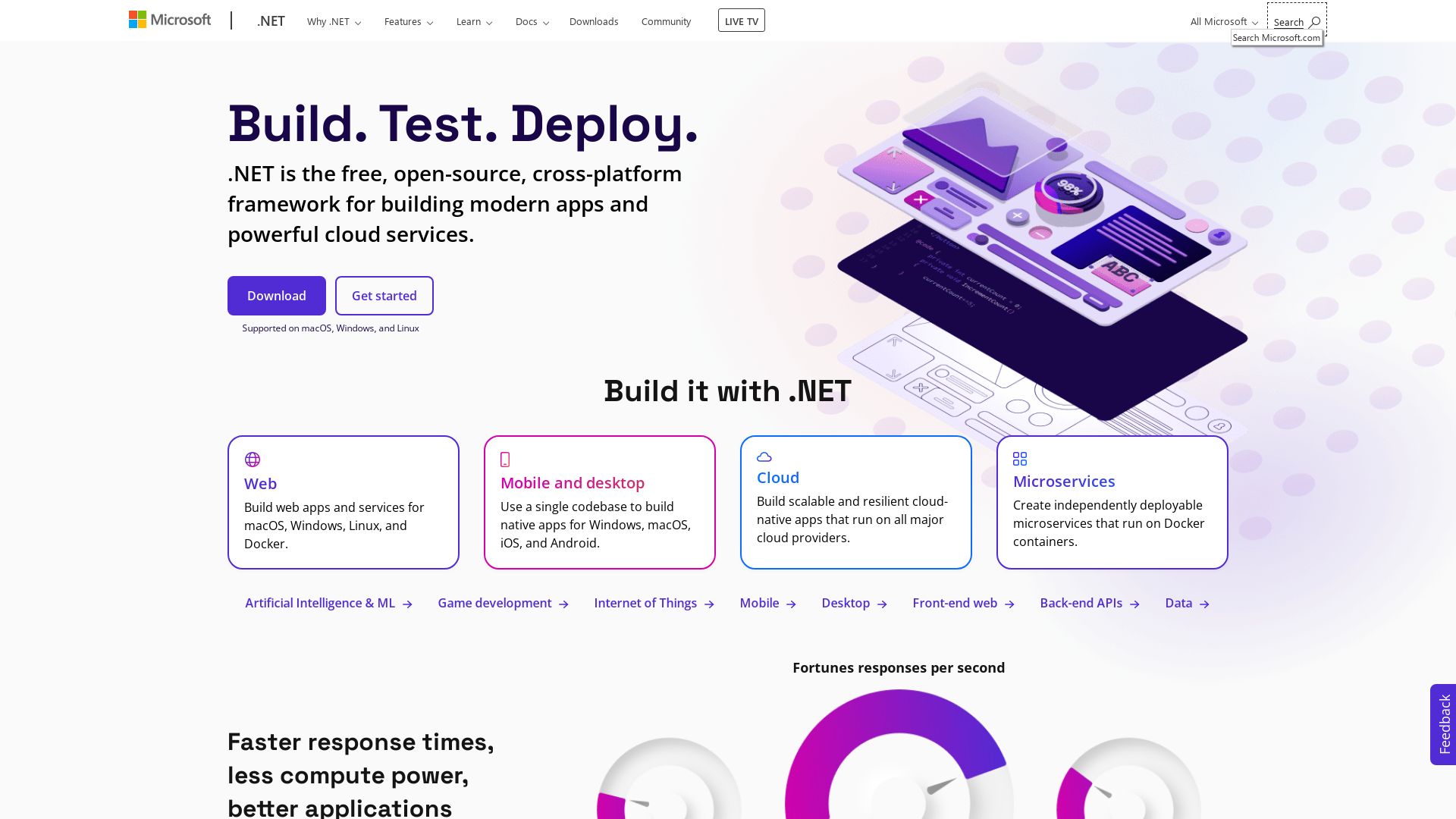
An open-source platform, Xamarin is engineered for crafting modern and native applications for iOS, Android, and Windows using .NET. Its convenience lies in its ability for developers to share, test, and orchestrate approximately 90% of their application across different platforms.
Top Features of Xamarin
- Robust Base Class Library (BCL): A comprehensive repository for highly resourceful programming code.
- Full binding for underlying SDKs: Complete immersion and interaction capability with native platforms.
- Xamarin.Forms: An open-source UI framework that streamlines app development across Xamarin.iOS, Xamarin.Android, and Windows applications.
- Wearable devices support: Xamarin forwards compatibility with devices such as Android Wear and Apple Watch, offering a truly cross-platform experience.
| Feature | Description |
|---|---|
| Modern Integrated Development Environment (IDE) | An advanced platform ideal for creating, testing, and debugging applications. |
| Mono Execution environment and Android Runtime (ART) compatibility | Enables smooth code execution and integration between different environments. |
| Cost-Effective and Time Efficient | Reusability of codes multiplied by low maintenance cost equals high efficiency. Ideal for app migration and works under tight deadlines. |
Xamarin Disadvantages
- Applications developed on Xamarin are larger than native apps.
- Compatibility issues can arise with third-party Libraries and Tools.
Xamarin Pricing
Bountiful as it is with features, Xamarin is an open-source platform, making it an ingenious choice for developers worldwide.
Xamarin Use Cases
Use Case 1: Cross-Platform Application Development
Xamarin merges the abilities of native platforms, making it an ideal choice for developers seeking to share code, test, and business logic across platforms.
Use Case 2: Rapid Application Development under Tight Deadlines
Its nature of enabling code reusability and low maintenance cost makes Xamarin suitable for projects working under tight deadlines.
Use Case 3: Building Applications for Wearable Devices
With support for wearable devices like Android Wear and Apple Watch, Xamarin carves its niche in the future of wearable technology.
JavaScript
JavaScript, a dynamic and lightweight computer programming language, is a preferred choice for web development as it effectively interacts with user interfaces to create dynamic web pages.
JavaScript Top Features
- Network-Centric: Specifically designed for creating network-centric applications.
- Browser Control: JavaScript has capabilities to control the browser, thus enhancing web page interactivity.
- Increased Interactivity: JavaScript enhances user interaction with immediate feedback to visitors.
- Node.js Compatibility: JavaScript can be used outside of the browser context with use of Node.js.
- Mobile App Development: Utilized in developing mobile applications.
| Server-Side Execution | Through Node.js, JavaScript runs on the server-side, improving performance. |
| Standardization | JavaScript follows the ECMAScript standard, ensuring uniformity and compatibility across platforms. |
| Fully Embedded | Present in popular web browsers, including Internet Explorer and Netscape. |
JavaScript Limitations
- JavaScript doesn’t support multi-threading or multiprocessing.
- For security reasons, it lacks certain features like reading/writing files and networking applications.
JavaScript Use Cases
Use Case 1: Web Page Interactivity
JavaScript offers immediate, user-friendly feedback, enhancing the visitor experience on interactive web pages.
Use Case 2: Network-Centric Applications
Being network-centric, JavaScript allows efficient encoding of data-driven, dynamic applications.
Use Case 3: Mobile App Development
JavaScript is used by big tech giants like Facebook, Twitter, and Google for mobile app development.
GDevelop

An open-source, cross-platform game engine, GDevelop, is developed by Google software engineer Florian Rival. Focused on creating PC, mobile, and HTML5 games, this tool offers its core library, game engines, IDE, and extensions to all developers, from non-programmers to experienced coders.
GDevelop Top Features
- Event-based Visual Programming: Enables users to create games irrespective of their programming skills.
- Multi-platform Compatibility: Runs on Windows, macOS, Linux and operates in a web browser.
- 3D Graphics and Animations: Offers advanced features for 3D graphics and animations.
- Extensibility: Developers can modify almost anything in the program, contributing to GDevelop’s development.
- Publication Platforms: Games can be published to PC, Web, Mobile platforms.
| Features | Description |
|---|---|
| Event Logic | Game logic is constructed using an intuitive, powerful event-based system. |
| Education & Serious Games | GDevelop is used in games education, from schools to university courses. |
| Project Outcomes | Planning, testing, publishing, game reviewing, and understanding of UI and UX. |
GDevelop Limitations
- Slower Development: Advanced users have more freedom but may experience slower development cycles.
- Less Stability: Higher propensity for stability issues in complex projects.
GDevelop Pricing
GDevelop is completely free.
GDevelop Use Cases
Use Case 1: Learning Game Design Tools and Techniques
Students can use GDevelop to explore its toolsets, enhance understanding of game features, create their games, and gain insights into game design tools techniques and terminology.
Use Case 2: Serious Game Development
instructors and trainers can use GDevelop to create learning/serious games for diverse educational settings.
Use Case 3: Indie Game Developers
Independent game developers can leverage GDevelop’s functionalities to build games without code and publish them on various platforms including Android, iOS and Steam.
jMonkeyEngine
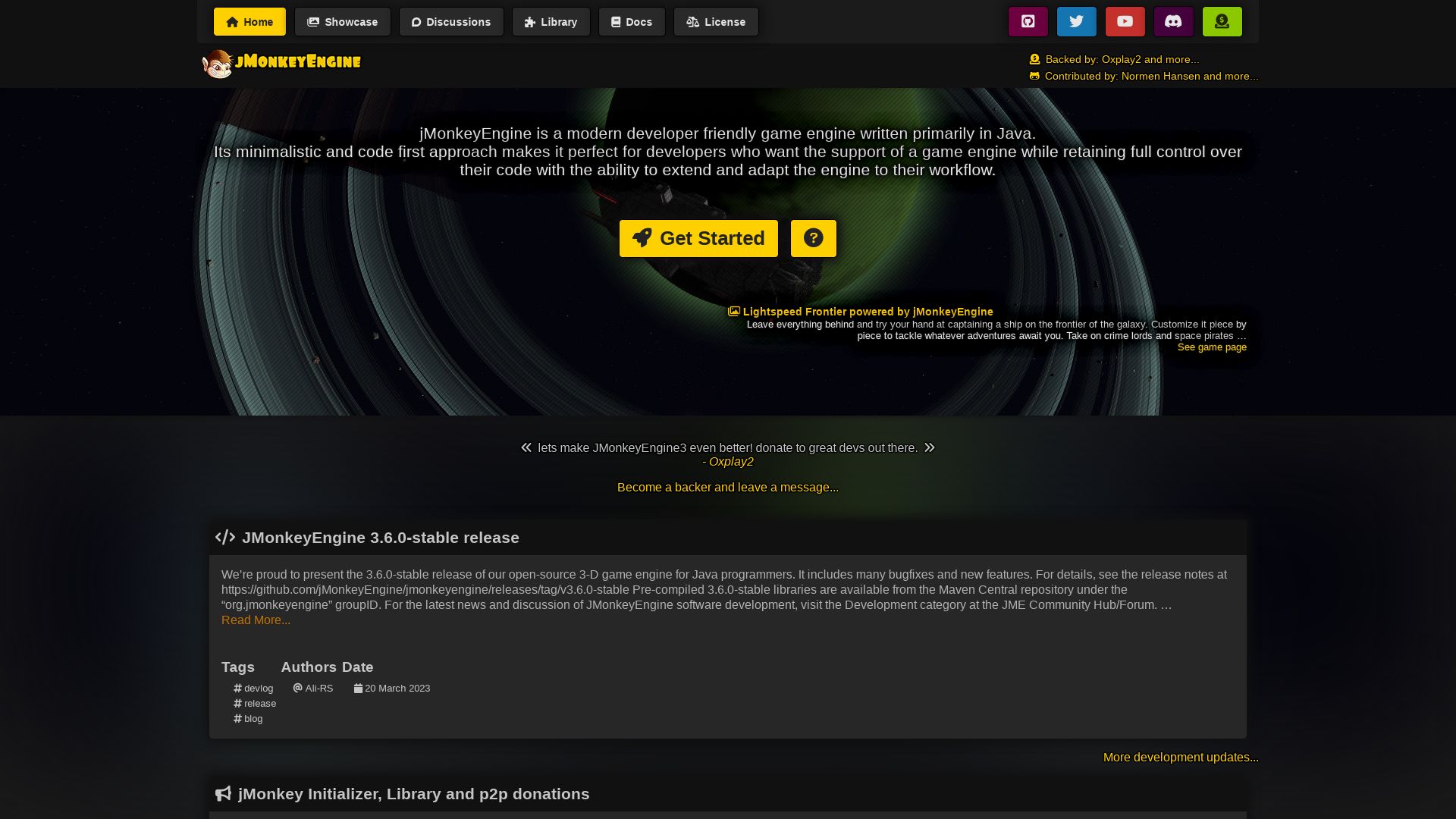
jMonkeyEngine is an open-source, Java-based game engine that presents a code-first approach to game development. Known for its minimalistic yet powerful framework, jMonkeyEngine is particularly attractive to developers who seek a comprehensive and compatible development platform.
jMonkeyEngine Top Features
- Java-based Engine: jMonkeyEngine operates on the NetBeans Platform, making it highly compatible and powerful.
- Cross-platform Support: The engine presents seamless adaptability to a variety of platforms, including PC, Linux, iOS, Android, and Mac.
- 3D Capabilities: From stunning post-process water and light scattering to advanced particle capabilities, jMonkeyEngine supports a wide range of 3D features.
| Feature | Description |
|---|---|
| Visual Options | jMonkeyEngine provides multiple GUI options such as Lemur, Nifty GUI, and IGUI for adaptable user interfaces. |
| Physics support | jMonkeyEngine supports multiple physics solutions including jBullet and Minie, bringing realism to the gaming experience. |
| Developer Community | The active community of developers, along with readily available documentation and tutorials, makes the learning curve easier. |
jMonkeyEngine Downsides
- Lacks the full suite of advanced features available in some more matured game engines.
- The focus on code-first development may be intimidating for beginners.
- Lower-level game development tool which may require more time and effort to create high-quality games.
jMonkeyEngine Pricing
jMonkeyEngine falls under the permissive BSD 3-Clause license model, making it completely free and open-source.
jMonkeyEngine Use Cases
Use Case 1: Educational Programs
jMonkeyEngine plays a big role in game-development education programs. Its ease of use and simpler learning curve makes it a preferred choice for both young and adult learners.
Use Case 2: Serious Game Development
Despite its minimalism, jMonkeyEngine is powerful enough to be used in serious game development. Many commercial games have been designed using this engine, which attests to its capability.
Use Case 3: Beginner Developers
With extensive online documentation, tutorials, and a supportive community, jMonkeyEngine serves as a great starting point for new developers keen on learning the ropes of game development.
RPG Maker
A legacy in game development software, RPG Maker positions itself as a robust tool, specifically catered for creating story-driven RPGs. The journey of this platform began in 1992, helmed by an ensemble of developers that includes ASCII, Enterbrain, Agetec, Degica, and Gotcha Gotcha Games.
RPG Maker Top Features
- Written in JavaScript & HTML5 featuring multilingual support (Japanese, Chinese, Korean, English).
- Wide platform availability from Windows, Mac, Xbox One, Nintendo Switch, Linux, PlayStation to Nintendo 3DS.
- RPG Maker MV, the latest iteration, offers an easy to use interface, strong character creation options, and cross-platform capability.
- Extensive DLC library, with over 200 options ranging from $5-$25, provides enhanced customization.
- Offers free plugins largely enhancing the functionality of the software.
- Strong community support that provides a steady flow of shared modifications.
| Final Version | RPG Maker MZ (Released August 27, 2020) |
| Unique Game Design | Due to the limitations, developers often create unique designs such as in Harvest Island. |
RPG Maker Limitations
- The engine is unable to cope with all types of game designs, thus may require a skilled developer to workaround limitations.
- Created games can spark controversy, as seen with “Super Columbine Massacre RPG!” and “Heartbeat”.
RPG Maker Pricing
Pricing for RPG Maker’s latest version, MV, may vary based on additional DLCs, which range between $5 – $25.
RPG Maker Use Cases
Use case 1 – Beginner Developers
The simplicity and flexibility of RPG Maker caters well to novice developers seeking to develop basic skills in game development.
Use case 2 – Story-driven Game Creators
Developers focusing on creating RPGs with strong narrative structures find RPG Maker’s story-centric approach beneficial.
Use case 3 – Platform Agnostic Developers
Given its cross-platform compatibility, RPG Maker serves as a valuable tool for developers seeking to deploy their games on numerous platforms.
GameMaker
Enter the realm of 2D game design with GameMaker, a robust engine perfectly primed for both beginners and veteran developers.
GameMaker Top Features
- Scalability: Revered from novices to fully-fledged developers, it tailors to a wide spectrum of skill levels.
- Mod.io Extension: Facilitates user-generated content integration to your game for heightened engagement.
- New Code Editor: Coming in 2023 with full-screen window access, enhancing efficient implementation of objects, events, and functions.
- AI Integration: Teaming up with OpenAI to simplify the game-making process – the future of game development.
- Markdown Support: Eases formatting for developers with its side-by-side preview functionality.
| 17 Years of Development | Evolved from Animo in 1999, it has been continually refined with a balanced mix of features and basic maintenance. |
| Language Server | Enhances Syntax Highlighting and Intellisense support for diverse languages like GLSL, HLSL, JSON, and XML. |
| Community Development | Thriving on feedback to drive updates and improvements, fostering a vibrant developer community. |
GameMaker Limitations
- Solely 2D: The engine revolves around 2D game development, limiting usage for 3D focused projects.
- Upcoming Updates: Major enhancements like the new Code Editor and AI integration would not be available before 2023.
GameMaker Pricing
Ranging from Free for beginners, to Creator, Indie, and Enterprise tiers designed for professional and console game development.
GameMaker Use Cases
Beginner Developers
An excellent launching platform for beginners, due to its simplicity and scalability.
Proficient Developers
Opens up multiple avenues for proficient developers with its extensive tools and Syntax Highlighting support.
Indie Game Studios
Perfect for Indie studios as demonstrated by the creation of indie hits like Undertale and Spelunky.
Kotlin

An open-source, statically-typed programming language, Kotlin merges object-oriented and functional programming strategies. Created by JetBrains and managed by the Kotlin Foundation, this influential language draws its inspiration from C#, Java, and Scala.
Kotlin Top Features
- Interoperable with Java, making existing Java libraries usable.
- Supports object-oriented and functional programming styles.
- Officially supported by Google for Android development.
- Existence of Kotlin-specific Android APIs like Android KTX.
- Safely designed with necessary object-oriented constructs
- Automatically handles casting and creates data classes.
- Devoid of static declaration, ensuring cleaner code structure.
- Despite running on JVM, it does not depend on it.
| Unique Feature | Description |
|---|---|
| Extensibility | Developers can extend class functionality without inheriting from the class. |
| Function passing | Functions can be passed as parameters, leading to more flexible code. |
| Data class | Presence of a data class, a class only containing state, aiding state management. |
Kotlin Disadvantages
- Lacks static declaration, which may affect certain coding patterns.
- Learning curve may be similar to Java due to similar syntax.
Kotlin Pricing
An open-source language, Kotlin comes without any pricing attached. Developers can use and contribute towards its progressive development for free.
Kotlin Use Cases
Use case 1: Android Apps
Kotlin, being officially supported by Google, becomes the go-to language for Android development, fostering reduced code length and fewer app crashes.
Use case 2: Server-side Applications
Considering its compatibility with Java Class Libraries, Kotlin finds extensive application in server-side development. Its concise and safe code structure aids in robust app development.
Use case 3: Multiplatform Mobile Development
With Kotlin’s interoperability with Java and its capability to target JVM, JavaScript, and native code, it stands as a solid choice for multiplatform mobile development.
Android Studio
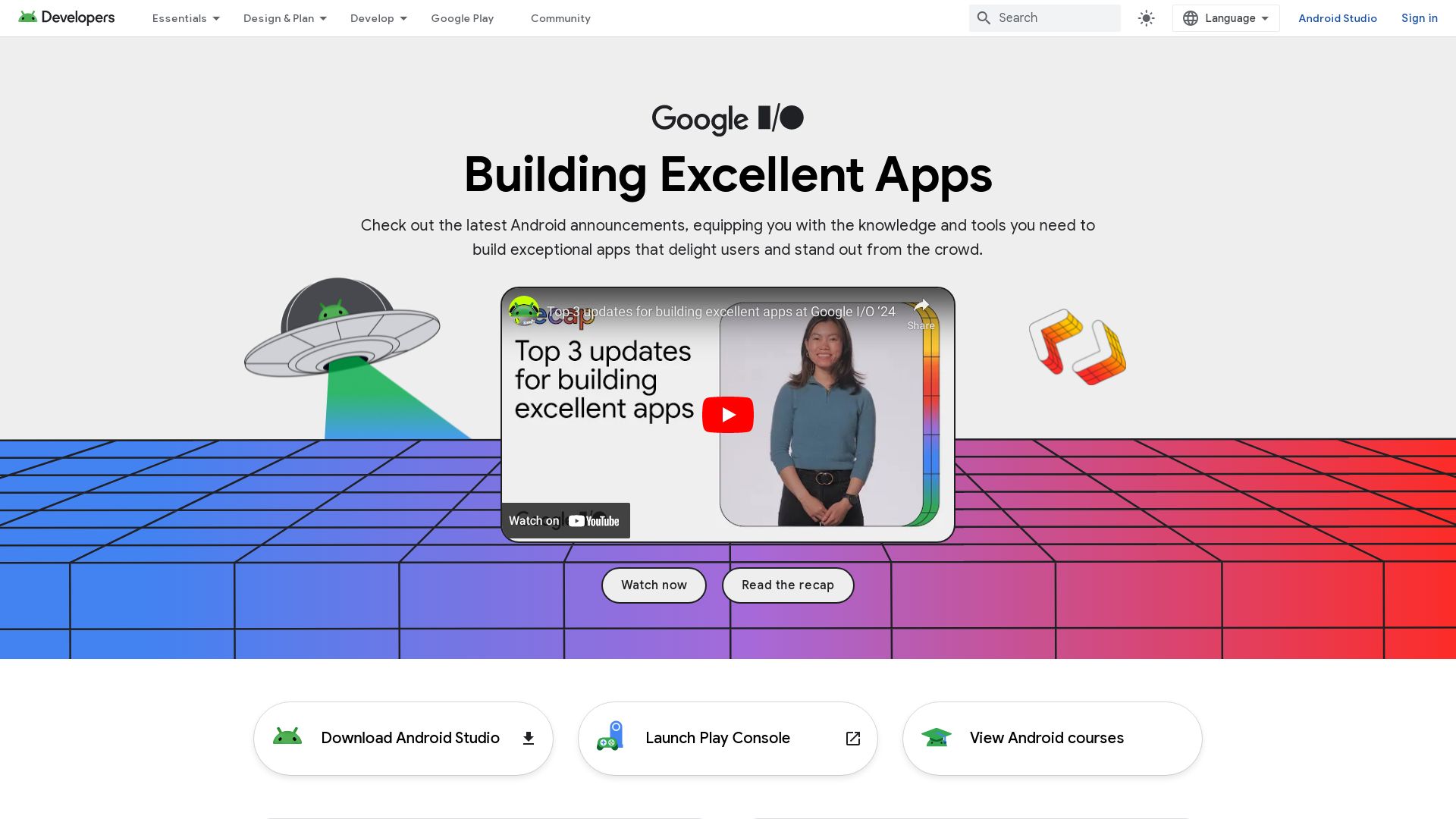
Behold the prowess of Android Studio, the official IDE for Android app development. This esteemed innovation, anchoring its foundations firmly in the IntelliJ IDEA code editor and developer tools, shines brightly with features resplendent, tailor-made for seamless development across all Android devices.
Android Studio’s Outstanding Features
- Remarkable flexibility offered by its Gradle-based build system and a rapid, feature-packed emulator.
- Live edit functionality, allowing for real-time updates of composites on emulators and physical devices.
- Exceptional testing tools and frameworks used for performance, usability, and version compatibility checks.
- Support for C++ and NDK, along with inbuilt support for the Google Cloud Platform.
- Customizability, extendability, and configurability of the build process, catering to a developer’s unique needs.
| Feature | Description |
|---|---|
| GitHub Integration | Facilitates feature building and sample code importation. |
| Smart editing | Empowering developers with advanced code refactoring, deep static code analysis, and other tools for high-quality app development. |
| Support for multiple languages | Android Studio nurtures development in languages like C++, Java, Kotlin, and more. |
Android Studio’s Limitations
- Demanding system requirements such as 8 GB RAM and 8 GB disk space, a 1280 x 800 screen resolution.
- May require a developer account sign in to facilitate tools requiring authentication, like Firebase.
Android Studio Pricing
Turn down the decibels of your clamoring curiosity, for the answer to your question is simple: Android Studio, with its immense playground of features, is entirely free.
Android Studio Use Cases
Use Case 1: App Developer
An app developer seeking to build robust Android applications will find Android Studio a paragon of excellence. Its powerful testing tools, live editing functionality and support for multiple languages make it an ideal choice.
Use Case 2: Cloud Service Developer
The inbuilt support for Google Cloud Platform in Android Studio makes it a boon for cloud service developers, enabling them to develop and deploy cloud-centric Android applications with relative ease.
Use Case 3: Enterprise Development team
Enterprises with a need to build multiple APKs for apps with varying features using the same project and modules will find Android Studio’s capabilities profoundly beneficial.
Xcode
An integral part of the global tech tapestry, Xcode is Apple’s very own Integrated Development Environment (IDE) for macOS. Enabling software development for a wide scope of Apple products such as iOS, macOS, watchOS, iPadOS, and tvOS, Apple has been championing digital diversity through this platform since 2003, with their latest release being version 15.
Xcode Top Features
- Built-in support for languages like C, C++, Objective-C, Objective-C++, Java, AppleScript, Python, Ruby, ResEdit (REZ), and Swift.
- Fosters the creation of fat binary files that can accommodate multiple architectures.
- The Instruments GUI tool, which runs on the DTrace framework allowing advanced performance, analysis, and debugging.
- Integrated support for Git version control, cementing its avant-garde tech status in the web development sphere.
- The innovative Playgrounds feature, which encourages rapid experimentation and development in Swift, has evolved into the Swift Playgrounds application for iPad, fostering a global tech unity for learning.
| Feature | Description |
|---|---|
| Dark Mode and Localization Support | Automatic support for elements including Dark Mode, localization, accessibility features, and dynamic type via Swift. |
| Interface Design | Automatic design system for responsive apps to echo the worldwide mobile-centric trend. |
| Mac Catalyst | Transforms an iPad app into a native Mac app. |
Xcode Limitations
- Requires Apple Developer Program subscription, which comes at a cost of $99 per year.
- While the Playgrounds feature is immensely educational, it no longer features Shared Workgroup Build and WebObjects tools and frameworks for Java web apps.
- Requires a Mac computer running the latest version of Xcode for iOS app development, limiting its accessibility to users across different platforms.
Xcode Pricing
Whilst the Xcode software itself is free of charge, available both from the Mac App Store and the Apple Developer website, Xcode does require an Apple Developer Program subscription, costing $99 per year.
Xcode Use Cases
Use case 1: Tech Education
The Playgrounds feature of Xcode fosters a conducive environment for rapid experimentation and learning in Swift, making it extremely useful for newcomers and budding coders.
Use case 2: Cross-Platform Development
With languages supported inclusive of C, C++, Objective-C, and more, Xcode poses as a versatile tool for developers looking to work on multiple architectures.
Use case 3: Apple-Centric Development
As an Apple IDE, Xcode is the go-to software for developers seeking to create apps for iOS, macOS, watchOS, and more, leveraging its robust support for Swift, AppleScript, and other languages.
Unreal Engine
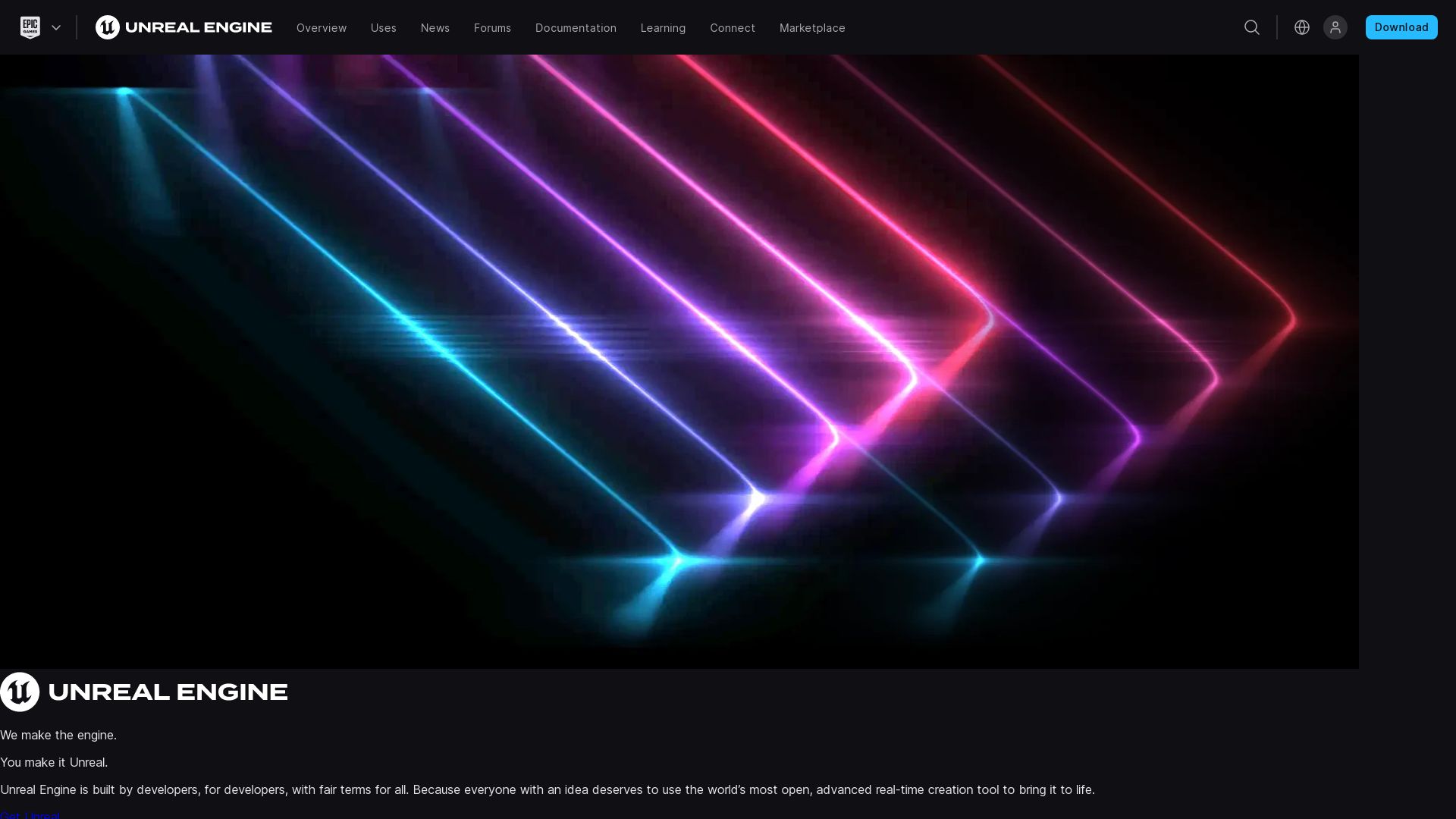
Unveiled in 1998, Unreal Engine is a series of 3D computer graphics engine by Epic Games. Initially designed for PC first-person shooters, it’s now utilized in various game genres, industries, including film and television, augmented, and virtual reality platforms.
Unreal Engine Top Features
- Written in C++
- Utilizes a level editor, UnrealEd
- Includes features from acquired companies such as Quixel
- Offers basic project templates that can serve as a foundation for a first-person or third-person experience
- Facilitates creation of iOS games and apps through the Unreal Development Kit
- Unreal Engine Marketplace enables developers to monetize their creations
| Tools | Editions |
|---|---|
| Unreal Engine 3 | Modder friendly, introduced UDK |
| Unreal Engine 4 | Introduced in 2004, supports creation of commercial products |
| Unreal Engine 5 | Latest edition, launched in April 2022 |
Unreal Engine Limitations
- Complexity of the programming language C++
- Epic charges 5% of revenues over $1 million
Unreal Engine Pricing
Epic Games follows a royalty model, charging users 5% of their revenues over USD 1 million. This royalty fee is waived for games published via the Epic Games Store. Educational institutions can leverage Unreal Engine for free. Developers selling on Unreal Engine Marketplace receive an 88% share of the generated revenue.
Unreal Engine Use Cases
Use Case 1: Game Development
For budding game developers or industry professionals, Unreal Engine provides all the tools needed to create a fully functional, visually stunning game.
Use Case 2: AR / VR Development
Augmented and Virtual Reality developers can utilize Unreal Engine to create immersive experiences across desktop, mobile, and console platforms.
Use Case 3: Film and Television
Unreal Engine is not just a game maker. Its features create high-quality visuals that lend themselves equally well to the film and television industry.
Unity

Introduced in 2005, Unity is a robust 3D and 2D game development engine empowering developers to build cross-platform games and applications.
The Star Features of Unity
- Flexible compatibility: Unity is adaptable with myriad operating systems, promoting the creation of applications from Augmented Reality to 3D simulations.
- Asset-rich store: Unity boasts a diverse store integrated with pre-designed textures and features, aiding developers in conceptualizing game designs.
- Versatile coding languages: Unity 3D provides a variety of coding languages, including BOO script, Javascript, and C#.
- Potent developer community: An active, cooperative community fosters feedback exchange for system improvements, offers support and facilitates problem-solving.
| Free and Pro Versions | Unity presents two versions packed with essential features, enabling the production of advanced games. |
| Continuous tech evolution | Unity is committed to elevate user-friendliness and provide immersive visual experiences with its continuously evolving technology. |
The Downsides of Unity
- Controversial Pricing Model: A new pricing model coming into effect from January 1, 2024, triggered backlash from developers, particularly solo, indie, mobile developers due to perceived harm.
- Fear of abuse: Developers worry about possible exploitation of per-install fees, as repeated downloads by a single user might inflate totals.
- Loss of Trust: Unannounced changes led to decreased trust between Unity and its users, fearing sudden pricing shifts and retroactive fees.
Unity Pricing
Unity operates on a pay-per-install model, charging developers each time their Unity-based game is installed. However, developers will not be charged an install fee until the game reaches $200k revenue and over 200k installations. Unity also promises to implement fraud detection practices to prevent charges for pirated copies.
Unity Use Cases
Mobile Game Design
Unity’s cross-platform capabilities make it a favourable choice for mobile game development, particularly for Android and iOS platforms.
AR/VR Game Creation
Developers interested in exploring AR/VR capabilities will find Unity a flexible engine for creating immersive games with augmented reality/virtual reality features.
Indie Game Developers
The functionality and adaptability offered by Unity is beneficial for indie game developers aiming to create sophisticated 2D or 3D games within budget constraints.
Eclipse
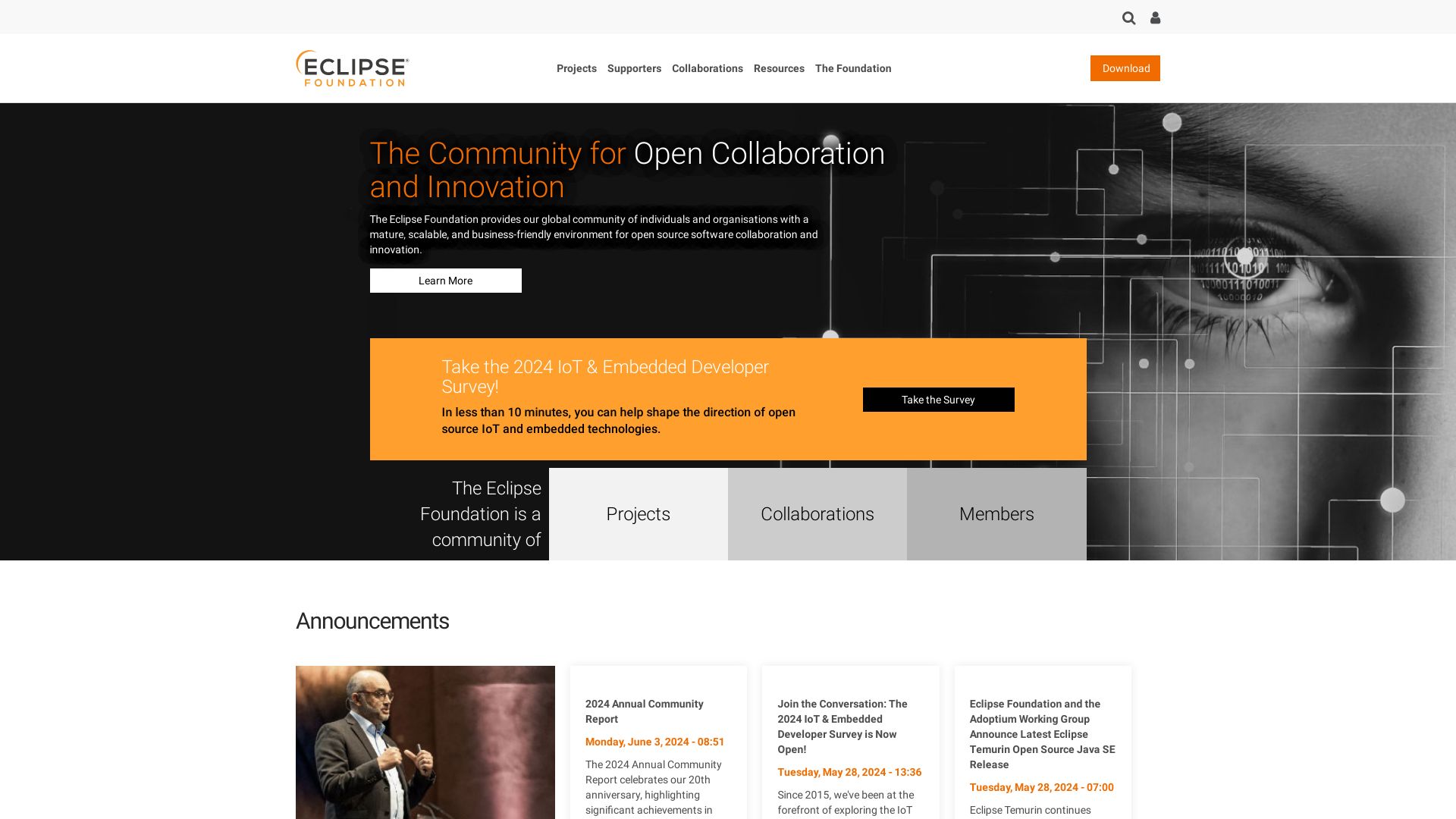
Emerging from the cradle of IBM in the late 90s, Eclipse swiftly rose to become a popular platform in computer programming. As an open-source Integrated Development Environment (IDE), it offers a versatile platform for writing and testing code in a multitude of languages.
Top Features of Eclipse
- Support for developing and testing code in multiple languages, including but not limited to, Java, Python, C++, Ruby, PHP, and JavaScript.
- Flexibility to extend its capability through additional plugins.
- Efficiently handles huge volumes of code with a compressed DB using SCID for project code.
- Based on the OSGi Service Platform, which offers a versatile runtime architecture.
- Comfortable transition from other platforms owing to its origin from IBM’s VisualAge.
| Feature | Details |
|---|---|
| Eclipse SDK | Offers beneficial tools for Java/Scala developers, also affects languages like C/C++, PHP, etc. |
| Equinox | Employed for managing plugins since 2004, fostering OSGi implementation. |
| 44 Integrated Languages | Includes a broad spectrum of programming languages, which can still be expanded through plugins. |
Limitations of Eclipse
- The Eclipse Public License may conflict with some compliance requirements being incompatible with the GNU General Public License.
- Initial use may be slightly challenging due to its extensive functionalities and diverse application scope.
- The individual classes are inaccessible outside the tool due to the usage of compressed DB using SCID for project code.
Eclipse Pricing
Eclipse is open-source and free to use, potentially removing barriers related to cost.
Eclipse Use Cases
Use Case 1: Java Developers
Being the second-most popular IDE for Java, Eclipse is a logical choice for both budding and experienced Java developers. Its robust Java development tools aid in crafting flawless programs.
Use Case 2: Agile Development Teams
Due to its agile development capabilities across multiple programming languages, Eclipse is a boon for project teams.Furthermore, its ability to accommodate additional plugins, and manage vast codebases efficiently makes it suitable for large development teams.
Use Case 3: Commercial Product Developers
Eclipse’s extensive functionalities provide a reliable foundation for developing commercial products. Adding to this, the multifaceted functionality allows for dynamic updates, thereby saving a significant amount of time and resources.
IntelliJ IDEA

Enter IntelliJ IDEA – the swiss army knife of Integrated Development Environments (IDEs). This brain child of JetBrains is not just built for Java and Kotlin, but is an all-terrain solution for other JVM languages such as Scala and Groovy, and can also boast of Python, Ruby, PHP, SQL, Go, JavaScript, TypeScript support via plugins.
IntelliJ IDEA Top Features
- Customizable: The Saby Mc Saverson of IDEs, IntelliJ IDEA, lets you tune the IDE appearance, layout, and code highlighting to your preference.
- Productivity Galore: With keyboard shortcuts baked in for almost every action, IntelliJ is the epitome of speed and productivity.
- Bundled Plugins: It comes packed with JetBrains’s other specific IDEs (PyCharm, WebStorm, PHPStorm) which helps integrate things for smoother action.
- Automatic Code Generation & Refactorings: Not a fan of manual labor? IntelliJ has got you covered as it offers automatic code generation and refactorings.
| Direct Database Access | Ultimate Edition grants heavenly direct access to databases via the built-in version of DataGrip. |
| Embrace Tools: | Integration with popular build tools like Gradle, Maven and others. |
| Server Support: | Supports application servers such as Tomcat, JBoss, WebSphere, WebLogic, Glassfish – quite the social butterfly! |
IntelliJ IDEA Downsides
- The product is a bit on the heavy side for systems with lower specs.
- Learning curve: Adaptability might be challenging for new users due to the multitude of IDE configurations available.
IntelliJ IDEA Pricing
For the deep-of-pockets, the IntelliJ IDEA Ultimate comes with an array of offerings but if you wish to avoid bad corpora-tea, there is an IntelliJ IDEA free version within the Early Access Program (EAP). Or Footloose with the open-source Community Edition and dance to the rhythm of Android and JVM development.
IntelliJ IDEA Use Cases
Use case 1
Whether you’re a lone ranger indie developer or part of a grunt Java army, IntelliJ IDEA assists with JVM and Android development in its Community Edition. Plus, it’s open source. ‘Open’-ing a bunch of possibilities, isn’t it?
Use case 2
Looking to solve big business problems or work on enterprise-level applications? You’re at right IDE-a with IntelliJ IDEA Ultimate edition. It gets its enterprise groove on with web and enterprise development. Docker machines, runneth over!
Use case 3
Are you the curious type, always looking to see what’s new? The Early Access Program (EAP) ensures you get a sneak-peek into future features that IntelliJ IDEA has to offer. It’s like seeing the future without a time machine. Bazinga!
BlueStacks
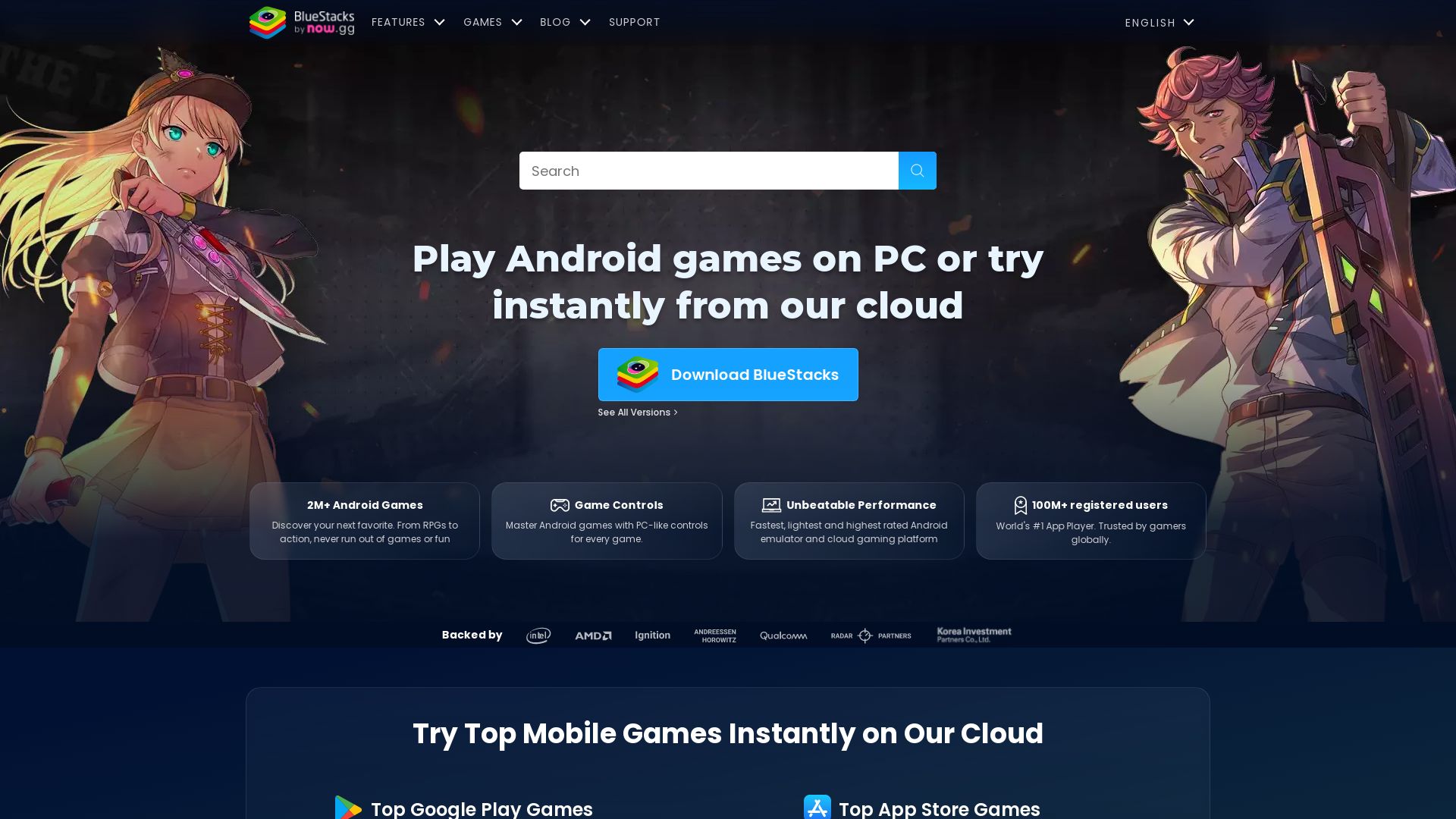
Nestled in the tech-savvy heart of Campbell, California, BlueStacks reigns as one of the top alternatives to Flutter. Founded by Jay Vaishnav, Suman Saraf, and Rosen Sharma in 2009, this transformative product from BlueStacks Systems, Inc. creates a seamless bridge between Android apps and desktop ecosystems like Microsoft Windows and macOS.
BlueStacks Top Features
- Android App Execution: Brings Android apps to life on your desktop with mouse, keyboard, and external touch-pad support.
- Syncing Capability: Synchronizes apps between your phone and PC, making data transfer effortless.
- MSI App Player Compatibility: Ensures 6X faster game performance than many flagship smartphones.
- High Frame Rate Support: Offers stunning visuals with high frame rate support up to 240 FPS.
| Latest Version | BlueStacks 5 (May 2021) |
| Downloads | Over 1 billion as of February 2021 |
| New Product | Cloud gaming service BlueStacks X (September 2021) |
BlueStacks Limitations
- System Requirements: Operations are not optimized for old machines, requiring Windows 7 or higher, 4GB RAM, and 5GB disk space.
- Forced Installations: Criticized for mandatory installation of BlueStacks X alongside BlueStacks 5.
- Performance Issues: Some users have reported glitches and laggy performance.
BlueStacks Pricing
At its core, BlueStacks is a freeware product, designed with the ethos of making tech more accessible, which allows everyone to bring their favorite Android apps to a desktop setting without any costs.
BlueStacks Use Cases
Use case 1: Gamers
The possibilities of gaming with BlueStacks are vast. From the exceptional graphics capabilities to the quick syncing features, it allows gamers to enjoy rich, fast-paced Android games directly on their desktop computers.
Use case 2: Developers
For developers testing Android applications, BlueStacks provides an ideal emulating environment. It supports simultaneous execution of multiple applications, granting developers a holistic view of system interactions.
Use case 3: General Users
For everyday users who wish to experience Android applications on larger screens, BlueStacks comes as an excellent solution. The manageable system requirements and cross-platform compatibility make it a friendly option for wide-ranging users.
Patrick Daugherty
Content writer @ Aircada. Merging AR expertise with a love for late-night gaming sessions.





